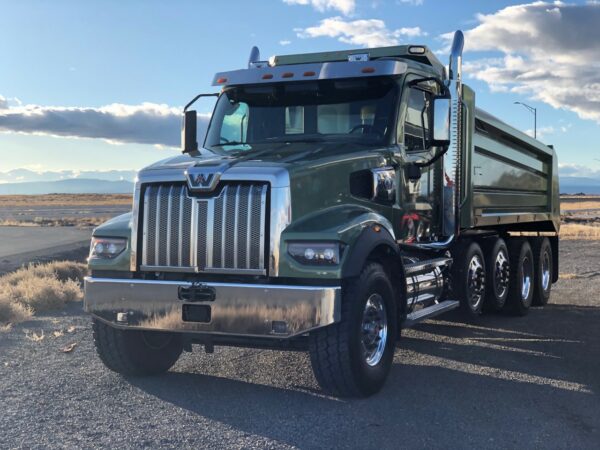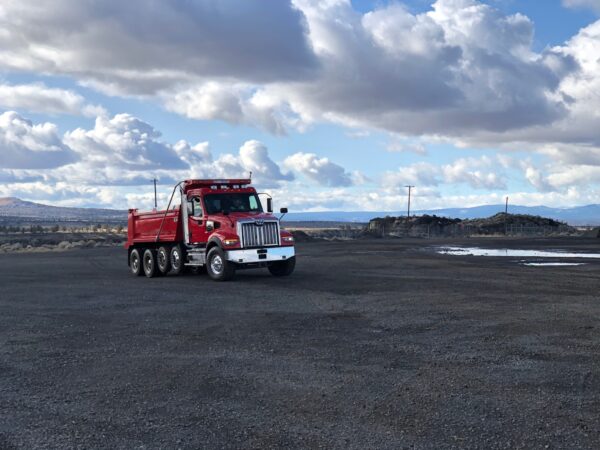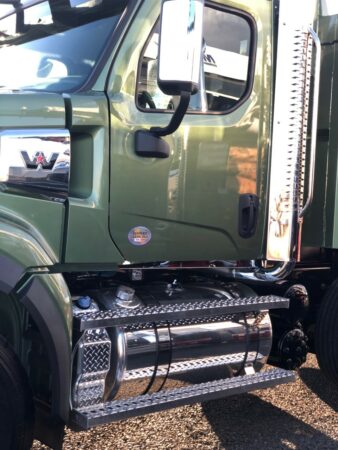Test Drive: Western Star’s 49X is a head-turning workhorse
Daimler executives weren’t happy.
You’d think they would be, given that the company’s North American trucks division is riding a Class 8, on-highway market share wave that would be the envy of any global corporation.
But market share domination comes at a cost. And that cost, in the words of one Daimler Trucks North America (DTNA) engineer, was an unacceptable showing in the vocational side of the Class 8 market.

“Our goal is to be the market share leader in the North American trucking industry,” says Tim Piete, lead engineer, DTNA. “To do that, it was clear that we needed to up our vocational game considerably.”
Enter the all-new Western Star 49X Class 8 vocational truck.
Piete, who served as the lead design engineer on the six-year project, says the truck represents a major step forward in terms of how DTNA will approach the North American vocational truck market in the future.
“We will be bringing a lot of the lessons we’ve learned from our hugely successful on-highway side of the business to our vocational products. This will include major technology upgrades on our vocational trucks, including our Detroit Assurance active safety system as key tools to help enhance driver safety, jobsite safety, and fleet productivity.”
More than that, Piete adds, the new 49X was designed simply to make life easier for fleets and the men and women who drive these trucks on North American jobsites. This includes new high-tech features like the global debut of the DT12 Vocational Series automated transmission, the aforementioned addition of the Detroit Assurance Safety System, and a driver-friendly automated pre-trip inspection system.
Canadian fleets can take a bit of pride in the research that DTNA engineers undertook to better understand how to make this new Western Star shine in even the harshest off-road conditions. To do that, Piete says, his team looked at every vocational application in North America, to determine which one was the harshest for Class 8 trucks.
“Right off the bat, we had our Texas oil field fleets assuring us that it was their jobsites that would when the ‘Worst’ title,” he says. “But when it was all said and done, our engineers determined that it is the harsh logging operations up in British Columbia, with their mix of rugged off-road conditions and absolutely brutal, fast-changing weather, that took the honors for Worst Application.”
It is an appropriate focus, given Western Star’s Western Canadian roots. But Piete says, once the data was in, Western Star engineers set out to make sure their new truck would be able to tackle those B.C. logging operations with confidence.
To that end, the 49X is also chock full of more low-tech enhancements as well, reflecting the type of work these trucks will do in the real world. This includes a new single-channel, splayed frame rail design; a safety-focused cab entry/egress system; an upfitter-friendly body design for easy wiring and hose routing; triple-sealed cab doors to keep heat and cool air in – and water out’ as well as an optimized roof design that keeps the overall truck profile as low as possible, while still providing plenty of headroom for hardhats in the cab.
Taken as a whole, the new 49X is a smart blend of cutting-edge technology combined with commonsense design cues taken from decades of hard lessons learned on jobsites all across North America.
At DTNA’s Truck Proving Grounds outside of Madras, Oregon, in mid-November, I was able to take several examples of the new truck through on-road and off-road courses, to see for myself what the company’s Class 8 vocational truck future looks like.

Safer, simpler and stunning
Western Stars have always been statement trucks. Their appearance, styling and creature comforts have always been a key selling point for fleets that want a truck which works hard, but stands apart from the crowd.
Knowing this, Western Star designers stuck with longstanding tradition and customer expectations when it came to the 49X’s exterior look. The truck has a solid, broad-shouldered stance about it that exudes confidence whether standing still and rolling down the highway. And it’s a Western Star. So you know there’s chrome. Lots of chrome, in fact.
The truck features a massive chrome grill with metal brightwork trim, as well as tasteful chrome accents on the side hood assembly and cab. All of this flashy trim is burnished by a host of eye-popping paint schemes, including brilliant red and white palates and a striking olive green that was my personal favorite. In keeping with long-standing Western Star tradition, the 49X is a truck that commands attention on the highway – a detail that Western Star aficionados wouldn’t have any other way.
On the side of the cab, the metalwork there has a definite, safety-focused purpose. Slips and falls are the second most common jobsite injury. And few mundane, repetitive tasks are as fraught with danger as climbing in and out of a muddy, wet truck cab on a crowded, noisy jobsite.
Understanding this, Western Star designers opted to move away from “ladder” style cab access, to a wider, more secure, “stairstep” cab entry and egress system. This rather elegant design flows seamlessly into the truck’s side profile and is bolstered by sturdy, reinforced handrails and grab handles that extend all the way up to the rearview mirror brackets, which deliver an astonishing absence of vibration — even in off-road driving — and can double as grab handles in a pinch. Even the map pockets at the base of each cab door feature an aluminum subframe capable of holding up to 300 lb. if needed. It’s a simple, rather obvious, design tack. But one that older geezers with suspiciously sore knees, like myself, will appreciate greatly.
Once up in the cab and settled in behind the steering wheel, the 49X continues to impress. The cab is well-lit thanks to the massive front and side windows. The overall effect is downright cheery thanks to all the sunlight streaming in, particularly if you’re in a day cab model with Western Star’s new three-piece rear window configuration behind you.
Old-school drivers will probably notice the 49X’s vastly simplified dash layout and instrument cluster in fairly short order. In large part, Piete says, this is a natural evolution given the massive leaps in visual display systems and vehicle-driver interface technology over the past decade. But fear not. Although the jet-cockpit-like array of endless dials, switches and gauges has been replaced by a much cleaner instrument display and dash layout, drivers will find the 49X information center to be infinitely customizable. With a few simple clicks, they can easily select which gauges or readouts are most important to them, and set them in a prioritized manner on the dash.
The large rocker switches down and to the right of the driver are within safe, easy reach, and can easily be manipulated, even when wearing heavy work gloves.

Help when you need it, full control when you want it
On the long oval track at the center of the Madras proving grounds, I found myself behind a truck that feels utterly at home on the open road. I’ve said for years now that I find Daimler Class 8 trucks to have the most “automotive” feel of any big rigs out there today. And the 49X didn’t disappoint on that front.
Class 8 powertrains and truck cabs have been getting progressively quieter for years now. And the gains made by all OEMs and powertrain suppliers have been stunning to behold. That said, the 49X may well be the quietest Class 8 truck I’ve ever driven. And that’s saying something, given that this is a vocational truck and not a dedicated longhaul tractor.
The lack of ambient noise, either from the road surface below, or the powerful DD12 and DD16 diesels up front, is remarkable. And the truck handling characteristics are outstanding, both at cruise speeds, or when negotiating a jagged, muddy, gravel track.
Even with all that bright high-desert sunshine streaming into the cab, the dash display on the 49X is crisp and clear enough to read at a quick glance. And all the ergonomic steering wheel and seating adjustment controls are simple and accurate enough to get comfortable and ready to drive with minimum fuss.
Thanks to many of the advanced safety features on the 49X, the driver has a lot of help going down the road. But traditionalists need not fret: For the most part, these control systems work quietly behind the scenes, and only step up and announce themselves when certain situations demand it.
That said, Western Star engineers also clearly understand that, at times, even the most well-intentioned autonomous vehicle systems can become a distraction or even a safety threat in certain situations. That’s why they’ve given drivers a great deal of control over how, when and where these systems come to life and lend a hand.
For example, every driver knows there are simply times that due to road conditions or other extenuating circumstances, you have no choice but to ride the center line on the highway. And the last thing you want is to have your lane-keeping assistance system constantly blaring warnings at you for something you’re doing on purpose. In that instance, Piete showed me how the driver can temporarily disengage that aspect of the Detroit Assurance system with a quick flip of a toggle switch. Doing so will disable the system for 15 minutes, assuming the vehicle does not exceed 82 km/h. It stays deactivated indefinitely as long as the truck stays under that speed threshold, Piete adds, to help drivers focus in construction zones or other constricted driving conditions.
Likewise, there are ton of new features packed into the DT12 Vocational Series automated transmission. While these systems are simple to use, they aren’t necessarily intuitive to initiate. So you’ll need to read the manual or get some coaching to get the most out of this remarkable gearbox. Still, this is a transmission that absolutely shines on both the pavement and in the mud. On the open road, the DT12 pulls as smoothly as any Cascadia I’ve driven, and the integrated engine brake is a massive help rolling down a steep mountain grade with 125,000 lb. of construction machinery on the flatbed pushing hard on the steer axle. And that same transmission can easily be put into “Rock Free” mode to give drivers complete control over the clutch and help a struck 49X power its way out of even deep, muddy, jobsite potholes.
If DTNA was seeking to make a statement with the launch of the Western Star 49X, it seems they’ve accomplished their mission. This is, in every conceivable way, as modern a Class 8 vocational work truck as there is on the planet, today. And yet, it still retains the styling cues and the sense of purpose that put a small, scrappy, West Coast Canadian truck builder on the map decades ago.
Without question, the 49X is a driver’s truck. But it’s also a smart and safe truck that North American fleets will find highly productive in even the toughest vocational applications.
Have your say
This is a moderated forum. Comments will no longer be published unless they are accompanied by a first and last name and a verifiable email address. (Today's Trucking will not publish or share the email address.) Profane language and content deemed to be libelous, racist, or threatening in nature will not be published under any circumstances.